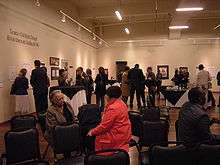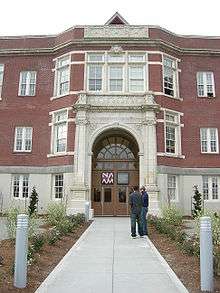Northwest African American Museum
The Northwest African American Museum (NAAM) serves to present and preserve the connections between the Pacific Northwest and people of African descent and investigate and celebrate Black experiences in America through exhibitions, programs and events. The museum is located in Seattle, Washington's historically African-American Central District neighborhood in the former Colman School (built 1909,[1] with official status as a City of Seattle landmark.[2] The building also contains 36 units of affordable housing.[3]
 Northwest African American Museum (NAAM) on its second day of operation, 2008 | |

| |
| Former name | Colman School |
|---|---|
| Established | 2008 |
| Location | 2300 S. Massachusetts Street Seattle, Washington |
| Coordinates | 47°35′20″N 122°18′06″W |
| Type | African American, art, history, culture |
| Architect | James Stephen |
| Public transit access | Beacon Hill Station King Street Station |
| Website | www |
| Designated | 2009 |
| Reference no. | 122950 |
History

The first efforts at creating the museum began in 1981,[4] by a multi-racial coalition called Community Exchange. In 1984 a formal task force was established. The following year, community activists Earl Debnam, Michael Greenwood, Charlie James and Omari Tahir-Garrett occupied the disused Colman School to claim the building as the desired museum location.[1] Tahir-Garrett's son Wyking Kwame Garrett later also participated in occupation, which continued for eight years.[5][6] Meanwhile, the city of Seattle, Seattle School District, and community activists explored other possible locations for the museum.
In 1993, a not-for-profit organization called the African American Heritage Museum and Cultural Center was formed and a Board of Directors was selected to oversee the project with Mayor Norman Rice's office. In 1995, Mayor Norman Rice appointed Bob Flowers as chairman of the museum board.[1] The Urban League became involved in the project in 2001[4] under the leadership of Board of Directors and CEO James Kelly and purchased the Colman School from Seattle Public Schools in 2003.[1] Unlike Flowers's group, the Urban League group had no continuity from the group that had originally occupied the building, leading to a split among African-American activists.[5]
Carver Gayton was appointed director of the museum and Barbara Earl Thomas was appointed curator in 2004-2005.[1] Ground was broken in spring 2006.[4] During the March 2008 opening ceremonies, Wyking Kwame Garrett seized the microphone and described the Urban-League-led museum as a "disgrace," a "scam," and "not what we sacrificed our lives for." He refused to leave or to be quiet, and was arrested. Nonetheless, Carver Gayton acknowledged the occupiers' role in bringing the museum into being: "They had a role in improving visibility of the African American Museum. They were part of that. We can't discount it." Similarly, Rev. Sam McKinney, former pastor of Seattle's Mount Zion Baptist Church, thanked the occupiers: "For eight years, they fought the wrecking ball."[5]
.jpg)
NAAM is among the cultural organizations in the city of Seattle that have originated through an occupation protest, including El Centro de la Raza and the Daybreak Star Cultural Center.[6][7]
Architecture
The museum is located in the former Colman School designed by James Stephen and built in 1909 in the Jacobean architecture style.[8] The building, a former elementary school, was nominated for landmark status by the Seattle Landmarks Preservation Board in 2005[8] and became an officially designated Seattle landmark in 2009.[2]
Facility

The museum has 17,000 square feet (1,600 m2) of floor space, including a bookstore/gift shop, galleries for temporary and permanent exhibitions, and spaces available to the public as rentals.[9] It is adjacent to Jimi Hendrix Park.[10]
The museum's inaugural exhibit featured the work of Jacob Lawrence and James W. Washington, Jr., two prominent, internationally acclaimed African American artists who made their homes in Seattle. Among the works in the show were Lawrence's series of five panels on the life of George Washington Bush, Washington State's first African American settler, and Washington's work from 1956 entitled "The Young Queen of Ethiopia," carved from Mexican volcanic stone. Though the artists came from different backgrounds and their art entreated different topics and mediums, "one thing they held in common was a firm belief in their own direction as artists. Their work moves us because they were clearly compelled to do it, to communicate deep social or inner truths. Both Lawrence and Washington did the painful work of finding their authentic voice as artists, a hard journey that few accomplish and which in itself sets them apart. That task was multiplied hugely by the fact that they were black men in a country with deep racial divides and prejudices. They were trailblazers, creating opportunities and helping others along the path. We can all benefit by the work they did."[11]
Notes
- Mulady, Kathy (2006-06-02). "African American Museum heading toward reality". seattlepi.com. Retrieved 2020-08-15.
- "Department of Neighborhoods". cityofseattle.gov. Archived from the original on 2011-07-21.
- Jones, Jeanne Lang (2007-09-20). "Seattle architect Donald King's DKA firm concentrates on community projects". Puget Sound Business Journal. Retrieved 2020-08-15.
- "Northwest African American Museum at Urban League Village", brochure
- Susan Gilmore, African American Museum opens to acclaim, Seattle Times, March 9, 2008. Accessed online 9 March 2008.
- Martinson, Nicole (July 6, 2020). "CHOP May Not Have Lasted, But These Occupied Spaces Did". Seattle Met. Retrieved 2020-07-27.
- Vansynghel, Margo; Kroman, David (June 17, 2020). "The future of Capitol Hill's protest zone may lie in Seattle history | Crosscut". Crosscut. Retrieved 2020-07-26.
- "REPORT ON DESIGNATION (former) Colman School" (PDF). Seattle.gov. Retrieved July 27, 2020.
- "NAAM - Venue Rentals". NAAM2020. Retrieved 2020-08-15.
- "Jimi Hendrix Park". Seattle Parks and Recreation. 2020-04-08. Retrieved 2020-08-15.
- Sheila Farr, Kindred spirits at Northwest African American Museum, Seattle Times, March 2, 2008. Accessed online 17 October 2013.
External links
- Northwest African American Museum, official site
- Susan Gilmore, African American Museum opens to acclaim, Seattle Times, March 9, 2008. Includes links to a gallery of photos of the museum on its opening day and to several Seattle Times articles from a special supplement about the museum.
- Mary T. Henry, Northwest African American Museum, HistoryLink, April 21, 2008.
- Stevens, Jeff, , November 24, 1985: The Colman School Occupation, November 12, 2011.
- Iwasaki, John, , School Board plans vote on sale of Colman School, February 26, 2003.
- , Allen Foundation donates $500,000 to the Urban League of Metropolitan Seattle for a capital campaign to develop the historic Colman School building in the city's Central District into affordable rental housing and the Northwest African American Museum.